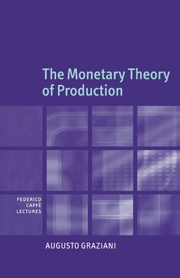Book contents
8 - Implications for monetary policy
Published online by Cambridge University Press: 03 July 2009
Summary
A basic issue: the endogenous nature of money
In discussing the implications of the circuit approach for monetary policy, a first preliminary issue has to be made clear concerning the nature and meaning of the assumption of endogenous money. In most macroeconomic models the money stock is treated as a given variable. A question remains open. When a variable is considered as a parameter, three possible interpretations are present:
The variable may be in the nature of a technical constant; a case which can be immediately set aside when the variable in question is the stock of money.
The variable may be considered as a parameter. In this case, its exact value is left undetermined and the analysis is meant to apply whatever the value of the parameter may be (this might be the meaning implied in Keynes's General Theory, when the author considers the money stock as given).
The variable may be determined by forces lying outside the model, for instance, in the case of the money stock, by the monetary authorities. This is perhaps the meaning implied in most macroeconomic models when dealing with the quantity of money. Of course, if a rule of conduct for the monetary authorities is defined and inserted as an integral part of the model, the money stock is no longer an exogenous variable and is endogenously determined by the solution of the model.
When introducing the concept of endogenous money, similar doubts can arise.
- Type
- Chapter
- Information
- The Monetary Theory of Production , pp. 138 - 143Publisher: Cambridge University PressPrint publication year: 2003



